A History of the American Movie Palace
By Hal Doby, originally written in 1996, last revision February 2013..
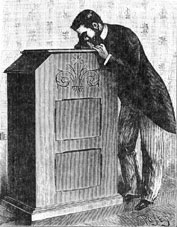 In
the begining, "Moving Pictures", now more commonly known as Motion
Pictures or simply "The Movies" were developed by many people in
many countries with the
major innovators being in the United States and France. Here in the
United States,
moving pictures were mainly pioneered by Thomas Edison's company, best
known for
his development of the electric light bulb and phonograph. His
company was the first to demonstrate moving pictures to the public
in the Americas. His
early experiments followed the same pattern as his phonograph,
with the pictures recorded on to a wax cylinder.
In
the begining, "Moving Pictures", now more commonly known as Motion
Pictures or simply "The Movies" were developed by many people in
many countries with the
major innovators being in the United States and France. Here in the
United States,
moving pictures were mainly pioneered by Thomas Edison's company, best
known for
his development of the electric light bulb and phonograph. His
company was the first to demonstrate moving pictures to the public
in the Americas. His
early experiments followed the same pattern as his phonograph,
with the pictures recorded on to a wax cylinder.
As an historical
note, Edison did not work alone. He had other scientists and engineers
working with him in his laboratory and while a lot of Edison's
inventions and technologies were directly credited to Edison himself,
there were others who rightfully deserved credit that went un-named.
In 1889, Edison handed the development of the moving pictures
project to a young Scotsman named William Kennedy Laurie Dickson.
Dickson stopped working with cylinders and began work on a system
that used strips of celluloid film, the same material that was
being developed for still photography.
Dickson's camera was called the Kinetograph. It used rolls
of film about 35mm wide with rows of holes down the sides to allow
the film to be pulled through the camera at an even rate by gears.
At the same time, Dickson developed a viewer for the films that
was called a Kinetoscope. One person at a time would look through
the viewing piece at the top of the box. The film ran through
a series of pulleys in a continuous loop, so that it could be
watched over and over again without rewinding.
Thomas Edison was renown for applying for patents for anything his
team of engineers designed. He wisely knew that should any of their
innovations become popular or useful, those patents would then require
anyone that used anything derrived from those patents, would owe Edison
a royalty fee. Also through those patents, Edison could control who,
how, when, and why those innovations were used. This has
made Edison a millionair through his patents for Electricity, the light
bulb and the phonograph. Now Edison was looking to make millions
through the control of the fledling film industry.
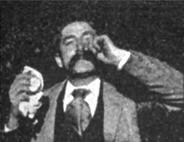 Edison's earliest
films lasted for about 20 seconds or less because of the amount
of film you could put into the camera. They were first demonstrated
to the public in 1893 at the Chicago World's Fair. By the following
year, a "Kinetoscope Parlor" opened in New
York, with ten machines showing different films. At right is an
early Edison film from the same time period that has been converted to an animated
GIF. "The Sneeze" is presented here uncut in its full
length to show you just how short "short" was back then.
Edison's earliest
films lasted for about 20 seconds or less because of the amount
of film you could put into the camera. They were first demonstrated
to the public in 1893 at the Chicago World's Fair. By the following
year, a "Kinetoscope Parlor" opened in New
York, with ten machines showing different films. At right is an
early Edison film from the same time period that has been converted to an animated
GIF. "The Sneeze" is presented here uncut in its full
length to show you just how short "short" was back then.
In order to understand the attraction to viewing these short
films, you have to remember that at the beginning of the 20th
century, the common person did not travel more than 25 miles away
from where they were born. Their life experiences were limited to
the things that were commonplace in their small communities. Things that
were not in their small part of the world were often considered to be very exotic and it
was exciting to see those things that were not part of their every day worlds. No
one had seen moving pictures before, so even a few moments of
action was astounding. The first films were very short and most were what was termed
Real Life Studies. Animals, city life, and the new modern wonders
such as the aeroplane and the horseless carriage were common subjects.
People who saw those films were voracious in their appetite to
see more to know more about the world around them.
 As the technology
progressed and longer moves could be made, they began to tell
short stories, but even then, they lasted just a few minutes in length. Kinetoscope parlors
sprang up all over the country and rows of Kinetoscopes were added
to existing entertainment venues like penny arcades. Operators
attempted to attract customers through sidewalk barkers and displays set up in their
wide entranceways.
It became an
enduring feature of movie theater construction still employed
today.
As the technology
progressed and longer moves could be made, they began to tell
short stories, but even then, they lasted just a few minutes in length. Kinetoscope parlors
sprang up all over the country and rows of Kinetoscopes were added
to existing entertainment venues like penny arcades. Operators
attempted to attract customers through sidewalk barkers and displays set up in their
wide entranceways.
It became an
enduring feature of movie theater construction still employed
today.
While Edison's invention was very prolific in the United States, In
Europe, Auguste and Louis Lumière became the European leaders in
the technical art of cinema. Unlike Edison, the brothers worked on the concept of
presenting thier films by a projector that projected the image on to a
large screen so a multitude of people could view a film at the same
time instead of one person at a time by looking into a Kinetoscope. The
Lumières held their first private screening of projected motion
pictures in 1895. Their first public screening of films at which
admission was charged was held on December 28, 1895, at Salon Indien du
Grand Café in Paris. This history-making presentation featured
ten short films, including their first film, Sortie des Usines
Lumière à Lyon (Workers Leaving the Lumière
Factory). Each film was 17 meters long, which, when run through a hand cranked projector, ran approximately 50 seconds.
When the Lumiere Brothers projection system came to America, the
Kinetoscope was quickly replaced in favor of the projection system
which is still in use today. Film exhibitioners preferred
presenting a single film
to a mass audience because simplification meant a lot more profit
was to be made. Gone were rows of expensive machines that had to
be individually maintained and each provided with a copy of a
film. In
their place was a single projector, one screen, and one film.
As these film theaters became commonplace, they were quickly
named. Nickelodeons. The term was derrived by combining the word
"Nickel",
the price of admission, with "Odeon," the ancient name
of Grecian theaters.The first Nickelodeon opened in Pittsburgh in 1905 (as shown
on the photo) when the proprietors of the Smithfield
Street movie house renamed their theaters Nickelodeons.
In 1904, a 24-year-old William Fox started the Greater New
York Film Rental Company with the purchase of a run-down Nickelodeon
in Brooklyn. With its success, he purchased more Nickelodeons.
As his fledgling chain of theaters began to grow bigger, Fox began to fight against the controlling
monopoly of the Motion Picture Patents Company owned by Thomas
Edison. Edison held his film patents tightly and using his power and
his company's vast financial resources, Edison's Kinetoscopes
dominated the American market. After long and heated court battles, Edison's monopoly came to an end in
1912 when the Supreme Court ruled in favor of William Fox.
The
age of the kinetoscope not only coming to an end as once Edison's
monopoly was broken, other entrepreneus almost overnight began to
establish new motion
picture studios.
Where Kinetoscopes were limtied to showing a film of a certain
length, projectors did not have this limitation. They could hold
as
much film as the bighest real used. During the time of the
Kinetoscopes, most films
were shot continuously. Any "editing" was done by turning the
camera on or off. Rarely were films were actually edited and
spliced together at the studio level. Around
the same time the Kinetoscopes were loosing popularity, filmmakers
began in earnest to
tell stores. To aid in their story telling, they began to make multiple
"takes" of scenes, then through editing and using multiple film
elements they were able to present more and more elaborate
stories. This was the beginning of the modern film.
Theater-goers began to enjoy two types of films. The traditional
"short-form" ran anywhere from a few minutes to about 20 minutes
in length. This was joined by a much longer
"feature film" that on average ran approximately 80 minutes or
longer. Going to the theater, even though it was relatively
cheap, was a big deal and theater operators had to present a program of
films that they felt gave the customer value for their five cents. News
organizations came up with the idea of taking film cameras to
record important
events and other news-worthy stories and they were put together as
weekly newsreels. By the early 1920s, the traditional movie
presentation had patrons watching one or two short films, a
current newsreel, trailers of upcoming films, and then finally the
feature film would conclude the program. All told, a viewing could last
three to four hours.
The first "theaters" were very simple and plain. They were usually
very spartan, smoke-filled,
and incredibly dingy. They were nothing more than simple rooms or store
fronts that had either a white-washed wall or a linen sheet hung
up on a wall to act as a screen. The chairs were loose and placed
into rows to suit the room. In the middle or rear of the room
sat the projector with its operator, who might also act as the
ticket vendor. Accompanying the film, was a piano, often played
by a girl or woman from the neighborhood, using whatever music
she had in her repertoire at the moment. Still, for a nickel you
could be transported into a fantasy world on the screen. The theaters
often included other attractions such as illustrated
song slides, song and dance acts, comedy, live dramas and other
features that allowed them to compete with vaudeville houses.
Theaters happily operated like this for almost two decades because
of the low-cost of operation. The popularity of these affordable,
entertaining,
and highly profitable venues was such that their numbers mushroomed
to approximately 8,000 in the United States by 1908.
Attendance was growing from a few people into the hundreds and
eventually thousands
at a time. Because of the growing number of patrons, the old ways of
showing films were
beginning to have serious safety considerations. New local and
federal public safety laws were made that started to have a direct
bearing on
the theaters and their operation. In the theaters,
should
there be a crisis, people could
panic with no regard for others and rush to the front doors. Chairs and
furnishings would
be tossed about and the human stampedes would cause as much injury
or death as the event that sparked the crisis. Fire was the number
one threat. Stage lights, the abundance of people smoking, and
the flammable nitrate-based films themselves were all serious risks that could result in disaster.
The average building could go up in flames very quickly.
With the new laws established, film exhibitors could no
longer convert a store front into a theater. The new entertainment
wonder had to evolve. The "next-generation" theaters often began as failed
opera houses, concert halls, or churches that were more readily
converted into theaters. The popularity of the
motion pictures was so great, pretty soon all of the available
buildings with some form of an auditorium were taken and demand
was still not satisfied. Even larger auditoriums were needed and
with the new safety rules it began to make much more economic sense to
construct new buildings instead of attempting to renovate
an existing structure. The new buildings would incorporate safety
features such as emergency exits, fire-retardant construction materials, and a separate projection room that separated
the equipment and the very 3 ew flammable film from the rest of the structure. Smoking
in the auditoriums was also banned as a further safety measure.
Motion Picures were not well
regarded
by upper society. Because of its popularity by "the common man" and
its origins in what many considered to be sleazy Nickelodeons or
"Flea Pits", the
members of upper society considered the "flickers" low-brow
entertainment. Yet, the pioneers of cinema had
become self-made multi-millionaires almost over night. Like a lot of
people that become wealthy through hard work instead of inheritance, it
became important to film's pioneers to make their industry
acceptable to
the members of high society while at the same time incease their appeal
to the common patron that made them wealthy in the first place. It
was hoped that someday the
fledgling industry would be held in the same high regard as
what other considered to Fine Arts; Dramatic Performance/Theater,
Ballet, Symphony, and Opera.

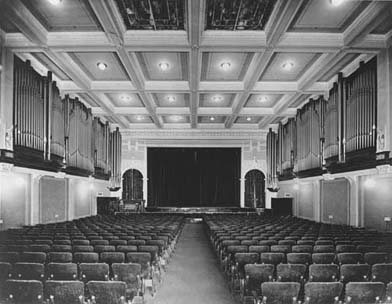 The first major step to that goal was taking the movies out of the
"flea pits"
and placing them into proper theaters that befitted the patronage
of refined gentlemen and ladies. Moving into
converted opera houses and purpose-built theaters did a lot to achieve
that
goal. Built in 1902, Tally's "Electric" Theatre in Los Angeles (shown at left) was
the first permanent structure devoted entirely to movies. Audiences immediately preferred the
comfortable, clean, and well-appointed surroundings of a proper
theater. They theaters also featured better-quality musical
accompaniments and even well-dressed ushers to assist patrons.
The first major step to that goal was taking the movies out of the
"flea pits"
and placing them into proper theaters that befitted the patronage
of refined gentlemen and ladies. Moving into
converted opera houses and purpose-built theaters did a lot to achieve
that
goal. Built in 1902, Tally's "Electric" Theatre in Los Angeles (shown at left) was
the first permanent structure devoted entirely to movies. Audiences immediately preferred the
comfortable, clean, and well-appointed surroundings of a proper
theater. They theaters also featured better-quality musical
accompaniments and even well-dressed ushers to assist patrons.
While this was decades away from the Great Depression, life was much more
hard than people know it to be in the 21st century. People loved
escaping their harsh worlds by getting involved in the stories this
new modern marvel told. Entrepreneurs soon caught on to the
idea of extending the fantasy world from just the screen image
to the whole experience of going to the movies. New movie theaters
were built not only to hold larger audiences, but their entire scale
and grandeur was put into overdrive. Because of these buildings
having such opulence and extraordinary architectural beauty, a
new term was coined. These were not mere theaters, they were Palaces where the average patron would be treated as
royalty. The Movie Palaces were such a commercial success, between
1914 and 1922, 4,000 Movie Palaces opened in the United States with many more to come.
 The
Regent (shown at left) was acknowledged as America's first motion picture
palace. Built for and operated by Jacob Fabian, it opened in Paterson,
New Jersey on September 14, 1914. The Regent was located
in a working class neighborhood up-town from the "legitimate" theater
district and stood between Old Union Street (which was later renamed
World Vet's Place in 1959) and Hamilton Street. As it was being
constructed, a majority of people believed that the huge cost of the
building's construction would prove to be a great liability. To that
end, it was oftern referred to as "Fabian's Folly" during the early
days, but once the theater was open and operating, the Regent proved
all of its ney-sayers to be wrong. A reporter for the Motion Picture
News declared that
the opening night audience "was the kind to be found at the
best playhouses. Judged by their decorum and sincere appreciation,
they might have been at the opera." Indeed, going to the
movie had gone from plopping down on a chair with a beer stein
in one hand and your cigar in the other, to putting on your finest
wardrobe to see and be seen alongside society's finest.
The
Regent (shown at left) was acknowledged as America's first motion picture
palace. Built for and operated by Jacob Fabian, it opened in Paterson,
New Jersey on September 14, 1914. The Regent was located
in a working class neighborhood up-town from the "legitimate" theater
district and stood between Old Union Street (which was later renamed
World Vet's Place in 1959) and Hamilton Street. As it was being
constructed, a majority of people believed that the huge cost of the
building's construction would prove to be a great liability. To that
end, it was oftern referred to as "Fabian's Folly" during the early
days, but once the theater was open and operating, the Regent proved
all of its ney-sayers to be wrong. A reporter for the Motion Picture
News declared that
the opening night audience "was the kind to be found at the
best playhouses. Judged by their decorum and sincere appreciation,
they might have been at the opera." Indeed, going to the
movie had gone from plopping down on a chair with a beer stein
in one hand and your cigar in the other, to putting on your finest
wardrobe to see and be seen alongside society's finest.
 Another
form of public entertainment was what was known as
Vaudeville. Vaudeville was a live performance theatrical genre of
variety entertainment
in the United States and Canada from the early 1880s into the early
1930s. Each performance was made up of a series of separate, unrelated
acts grouped together on a common bill. Types of acts included popular
and classical musicians, dancers, comedians, trained animals,
magicians, female and male impersonators, acrobats, illustrated songs,
jugglers, one-act plays or scenes from plays, athletes, lecturing
celebrities, minstrels, and movies. Vaudeville developed from many
sources, including the concert saloon, minstrelsy, freak shows, dime
museums, and literary burlesque. Called "the heart of American show
business," vaudeville was one of the most popular types of
entertainment in North America for several decades. Most performers and
artists joined travelling Vaudeville
troops and they traveled from town to town, but a few continually
performed in
one location. A few performers gained what today we would call
"superstar" levels of popularity and they would strike out on their own
to travel around the country. As film's popularity exploded, it
had a direct and
very negative effect on Vaudeville and in by the 1930s, Vaudeville was
almost
completely put out of business.
Another
form of public entertainment was what was known as
Vaudeville. Vaudeville was a live performance theatrical genre of
variety entertainment
in the United States and Canada from the early 1880s into the early
1930s. Each performance was made up of a series of separate, unrelated
acts grouped together on a common bill. Types of acts included popular
and classical musicians, dancers, comedians, trained animals,
magicians, female and male impersonators, acrobats, illustrated songs,
jugglers, one-act plays or scenes from plays, athletes, lecturing
celebrities, minstrels, and movies. Vaudeville developed from many
sources, including the concert saloon, minstrelsy, freak shows, dime
museums, and literary burlesque. Called "the heart of American show
business," vaudeville was one of the most popular types of
entertainment in North America for several decades. Most performers and
artists joined travelling Vaudeville
troops and they traveled from town to town, but a few continually
performed in
one location. A few performers gained what today we would call
"superstar" levels of popularity and they would strike out on their own
to travel around the country. As film's popularity exploded, it
had a direct and
very negative effect on Vaudeville and in by the 1930s, Vaudeville was
almost
completely put out of business.
But as theaters moved into purpose-built houses, most were able to
accomodate live performances and that allowed theater owners to offer a
split bill of both film and Vaudeville performances.Vaudeville circuits
groups like Keith-Albee became
absorbed into motion picture corporations such as RKO
(Radio-Keith-Orphieum). Thier performers not only continued to perform
live, but also began to work as actors in films.
After dominating
the motion picture industry at the beginning of the century, Edison's monopoly gave way
to a handful of film companies that rapidly achieved what they called "Vertical
Integration" of the industry. The film studios controlled every aspect of the
"product" they manufactured. The studio "owned"
the players and film production teams by contract; they controlled
the subject matter and the owned the final product. Once it was
made, the studio would then self-promote the film and distribute
it to be shown at theaters that were mainly wholly owned by the same
studio.
It became increasingly harder for individual independent
entrepreneurs
to show new first-run films because none of the
studios would allow their films to be shown in theaters not owned
or in partnership with them. In the eyes of many, this had replaced
Edison's monopoly with other monopolies that forced almost all of
the
independent exhibitors to sign into a studio network agreement,
sell the theater to a studio, or close their doors. Of course,
legal challenges were filed, but it took almost 4 decades for
them to wind their way through the United States legal system
before the United States Supreme Court hear the case. .
As the legal challenges found their way to the highest court in the
land,
the damage had already been done. In a few short years the studios
totally
controlled movie production, distribution, and exhibition in the
U.S. The "Big Five" were Famous Players-Lasky (later
Paramount), Warner Brothers, Loew's / Metro-Goldwyn-Mayer,
Fox Films, and RKO. By 1929 Paramount operated
1200 theaters with Fox close behind at 1100. In 1930, the five
major film companies took in approximately 70% of all box office
receipts
in the United States.
Many of the studio heads, architects, and film exhibitors
were first-generation Americans. Among them were William Fox and
Samual Rothapfel, often called by his nickname "Roxy". Their
experiences as first-generation Americans might have given
them a different perspective on American consumer culture, but
instead they became some of its most ardent champions, and their
theaters became some of its most unforgettable monuments. Most
of 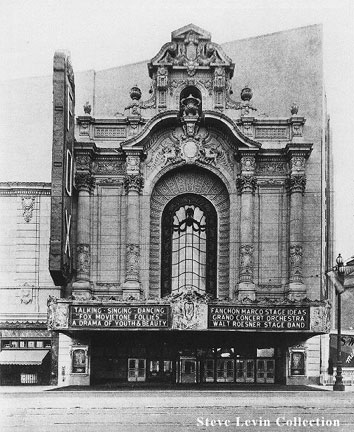 the great palaces were
designed and created by three architectural firms: Rapp and Rapp,
John Eberson, and Thomas Lamb for the "Big Five" studios. A healthy competition of sorts was had between the
three firms to see who could out do the others latest achievement.
Each new palace was becoming "the new modern wonder of the
world". Most movie palaces were built mainly employing themes from
Europe's grand architecture. The rule of thumb was the more ornate,
the better.
the great palaces were
designed and created by three architectural firms: Rapp and Rapp,
John Eberson, and Thomas Lamb for the "Big Five" studios. A healthy competition of sorts was had between the
three firms to see who could out do the others latest achievement.
Each new palace was becoming "the new modern wonder of the
world". Most movie palaces were built mainly employing themes from
Europe's grand architecture. The rule of thumb was the more ornate,
the better.
 Everything about
the movie palace was designed to make the average citizen feel like a celebrity,
a millionaire, or royalty. When the San Francisco Fox (The exterior
is shown on the left while the lobby is depicted to the right)
opened in June of 1929, newspaper and magazine advertisements
proclaimed:
"No palace of Prince or Princess, no mansion of millionaire
could offer the same pleasure, delight, and relaxation to those
who seek surcease from the work-a-day world, than this, the Arcady
where delicate dreams of youth are spun...Here in this Fox dream
castle, dedicated to the entertainment of all California, is the
Utopian Symphony of the Beautiful, attuned to the Cultural and
Practical...No King...No Queen...had ever such luxury, such varied
array of singing, dancing, talking magic, such complete fulfillment
of joy. The power of this Purple we give to you...for your
entertainment.
You are the monarch while the play is on!"
Everything about
the movie palace was designed to make the average citizen feel like a celebrity,
a millionaire, or royalty. When the San Francisco Fox (The exterior
is shown on the left while the lobby is depicted to the right)
opened in June of 1929, newspaper and magazine advertisements
proclaimed:
"No palace of Prince or Princess, no mansion of millionaire
could offer the same pleasure, delight, and relaxation to those
who seek surcease from the work-a-day world, than this, the Arcady
where delicate dreams of youth are spun...Here in this Fox dream
castle, dedicated to the entertainment of all California, is the
Utopian Symphony of the Beautiful, attuned to the Cultural and
Practical...No King...No Queen...had ever such luxury, such varied
array of singing, dancing, talking magic, such complete fulfillment
of joy. The power of this Purple we give to you...for your
entertainment.
You are the monarch while the play is on!"
In large towns, it was common for more than one movie palace
to be built and it seemed where multiple theaters were, there
was a very healthy competition to make the next theater bigger,
better, and more over the top. Even in small cities and towns
where there was no direct competition, lavish theaters were erected
were citizens had never seen
such opulence. While not true "palaces", these theaters
were an important part of American culture. In the smaller towns,
movie theaters became cultural centers for their societies. Societal
life began to revolve around what was going on at the theaters.
In addition to the regular movies, the theaters would be rented out
for special events such as school graduations, traveling lectures,
community theater, and weddings. It was very common (and still
so today) for theaters to open their doors on Sunday mornings
to be used by church groups that didn't have their own sanctuary.
The Great Depression took its toll on the palaces. Theater
attendance dropped from 90 million per week in 1930 to 60 million
per week two years later when the Depression was at its worst. During the same period, the number of
operating theaters fell from 22,000 to 14,000. People were doing
good just to survive, and going to the movies became a rare luxury.
Theater managers had to trim their own operations just to keep
the doors open. The first thing to go was live acts.
They soon learned that by making the program shorter, they could
have more than one show a night, which meant more revenue. The standard
evening program had a newsreel, a cartoon, perhaps a short special
interest film, previews, and the feature. Weekend Matinees would
commonly add an episode of a serial adventure such as an adventure of
Buck Rogers, Flash Gordon, Roy Rogers, Batman, Tarzan, and Dick Tracy.
Another thing that might seem unbelievable today was the early
theaters did not have food concessions. Since the movies were trying to
emulate "The Arts", people simply did not eat or drink during
those performances, so why should going to this new art form be any
different? Some theaters allowed people to sell food and drinks
outside the theaters that people were allowed to bring in. Some patrons
actually
brought their own sandwiches or snack food with them from home. As the
exhibitors grew desperate for revenue, they realized that this was a
potentially vital stream of income they had not tapped into! In short
order, outside food and drink was banned as concession stands were
put into the theaters. By the late
20th Century, most exhibitors made the majority of their income at the
concession stand because most film distributors demand over 90% of the
money generated from ticket sales. (Editor's Note: This is why I always
make a point to buy popcorn and drinks in order to actually support my
local theater!)
Despite their best
efforts, many theaters did not make it and were boarded
up. San Francisco's Fox Theatre went dark in 1932, just three
years after it's opening, when Fox Films declared
bankruptcy. Thanks to William Fox's attempt to
control
Loew's Inc/MGM through the purchase of stock in a leverage buyout, it
was partly owned by Fox when Fox Studios went
into receivership. As part of the court negotiated liquidation of
Fox Films assets, Loew's Inc.eventually emerged from the Fox
bankruptcy owning a substanial part of the Fox Theater
chain. Fox Studios was sold and eventually merged
with Twentieth Century Studios. The new corporation was renamed
Twentieth Century-Fox (the hyphen is important!). In 1935. Famous
Players/Laskey fell into receivership in 1933, but it was
able to reorganize and it emerged from bankruptcy intact in
1936 as Paramount Pictures. RKO entered into
bankruptcy protection in 1934 and reorganized in 1939.
Universal sold its theaters as a stopgap measure but fell into
receivership in 1933. It emerged from reorganization in 1936.
Only Warner
Brothers, Columbia, and United Artists survived the Depression
without having to declare bankruptcy and their theater chains left
intact.
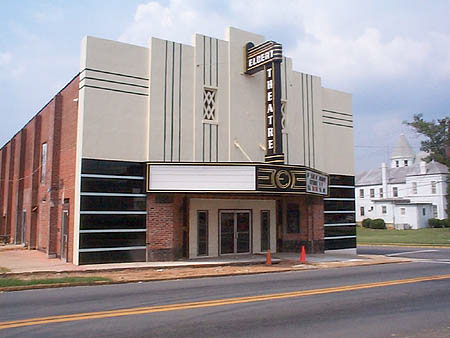 As the economy slowly recovered,
the picture palaces that survived the Great Depression began to
enjoy a renaissance but it was never to be as it was prior to 1929. The
Great Depression had a tremendous effect on the American Society well
beyond just the financial aspects of the stock market crash. From Black
Monday until mid-1932,
things went from bad to worse before improvements slowly began.
As the economy slowly recovered,
the picture palaces that survived the Great Depression began to
enjoy a renaissance but it was never to be as it was prior to 1929. The
Great Depression had a tremendous effect on the American Society well
beyond just the financial aspects of the stock market crash. From Black
Monday until mid-1932,
things went from bad to worse before improvements slowly began.
One
of the more recognized shifts occurred with the election of Franklin
Delano Roosevelt as President in 1932. As part of his election
campaign, he promised a "New Deal" to the American populace. With that,
Americans began to look towards an eciting new future and with that,
they abandoned a lot of the conventional perceptions of wealth and
luxury and moved towards a new asthetic. The opulant style old-world
European style quickly fell out of fashion. The ultra-modern style, now called Art Deco, was immediatley embraced.
Please Note: During the years when Art Deco was a fashion style, the term Art Deco was not used. The terms. Modernistic, Moderne,
or Style/Art Moderne referred to this style until the term Art Deco
was coined in the 60's by Bevis Hillier, a British art critic
and historian. He derrived the name Art Deco from the 1925 Exposition
Internationale des Arts Decoratifs Industriels et Modernes, held
in Paris, where the Moderne style was recognized as a unique art form, different from other
art forms/styles.
Although
Art Deco was originally started in Europe, it had greater achievement
in architecture and interior design in the United States and today
is pretty much recognized as an American art form. Art Deco was
derived from another artistic expression, Art Nouveau that developed
in the 1880s. Art Nouveau was a concerted attempt to create an
international style based on decoration. Art Nouveau designers
believed that all should work in harmony to create a "total
work of art," or Gesamtkunstwerk: buildings, furniture, textiles,
clothes, and jewelry all should conform those principles. Art
Deco first appeared in the 1920s. It is a "modernization"
of many artistic styles and themes from the past. You can easily
detect in many examples of Art Deco the influence of Far and Middle
Eastern design, Greek and Roman themes, and even Egyptian and
Mayan influence. Modern elements included echoing machine and
automobile patterns and shapes such as stylized gears and wheels,
or natural elements such as sunbursts and flowers. The modern
art movements of Cubism, Futurism, and Constructivism influenced
Art Deco; however, it also took some ideas from the ancient geometrical
design styles, such as Egypt, Assyria and Persia. Art Deco designers
use stepped forms, rounded corners, triple-striped decorative
elements and black decoration often. The most important
Art Deco element is that all elements are in simple
geometrical order. If one is looking for appropriate words to
describe overall Art
Deco as a design style, "simplistic", "streamline", and "speed"
come to mind. During the Great Depression, Art Deco buildings
had very little protruding ornamentation and have very flat,
streamlined
looks.
Architects and
builders constructed the last large movie palaces in the 30s
during the
Great Depression, but they were nothing like the palaces that were
built prior to 1929. Art Deco had replaced the previous ornate
styles
of architecture and it became the standard in movie theater
design. There
are a lot of views as to why the movie palace architects
made such a fast transition to Art Deco. My opinion is there
were two driving factors to adopt Art Deco. The
first reason is economical. It was a substantially simpler to
design
and a lot less expensive to construct. Secondly, after we
were plunged into the Great Depression which,
pardon the pun, was depressing, we longed for a bright new future.I do
not think
there has been any other period in the history of man where we
as a civilization have looked so forward to the prospects of a
wondrous future. The Moderne style was so new, it embodied the promise
of that bright and exciting future. The Moderne style WAS the future. It was the harbinger of that
incredible future. In my
opinion, the 1939 World's Fair in New York was the epitome of this
expression with the General Motors exhibition, the World of Tomorrow
literally at its pinnacle.
As the world recovered from the Depression and before War loomed on the
horizon, the old European ornate styles were considered very dated and
out of fashion. Moderne / Art Deco was en vogue and pointed the way
to the sleek new future that lay ahead.
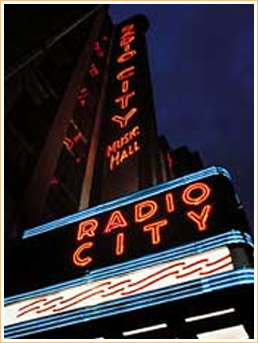 The first
Art Deco palace was designed in 1930 by Marcus Priteca. It was the Hollywood
Pantages at Hollywood and Vine in Los Angeles. While many others
were built, without a doubt, the most famous
Art Deco theater, and undeniably the most famous existing movie palace
in the world, is Radio City Music Hall. More than 300 million
people have patronized Radio City to enjoy stage shows, movies,
concerts and special events. Everything about it is larger than
life.
The first
Art Deco palace was designed in 1930 by Marcus Priteca. It was the Hollywood
Pantages at Hollywood and Vine in Los Angeles. While many others
were built, without a doubt, the most famous
Art Deco theater, and undeniably the most famous existing movie palace
in the world, is Radio City Music Hall. More than 300 million
people have patronized Radio City to enjoy stage shows, movies,
concerts and special events. Everything about it is larger than
life.  Radio City Music
Hall opened on December 27, 1932. Donald Deskey designed the Music
Hall's interior spaces. In his design, Deskey chose elegance over
excess, grandeur above glitz. He designed more than thirty separate
spaces, including eight lounges and smoking rooms, each with its
own motif. Given "The Progress of Man" as his general
theme, he created a stunning tribute to human achievement
in art, science and industry. He made art an integral part of
the design, engaging fine artists to create murals, wall coverings
and sculpture; textile designers to develop draperies and carpets;
craftsmen to make ceramics, wood panels and chandeliers. Deskey
himself designed furniture and carpets, and he coordinated the
design of railings, balustrades, signage and decorative details
to complement the theatre's interior spaces. It remains an elegant,
sophisticated, unified tour de force.
Radio City Music
Hall opened on December 27, 1932. Donald Deskey designed the Music
Hall's interior spaces. In his design, Deskey chose elegance over
excess, grandeur above glitz. He designed more than thirty separate
spaces, including eight lounges and smoking rooms, each with its
own motif. Given "The Progress of Man" as his general
theme, he created a stunning tribute to human achievement
in art, science and industry. He made art an integral part of
the design, engaging fine artists to create murals, wall coverings
and sculpture; textile designers to develop draperies and carpets;
craftsmen to make ceramics, wood panels and chandeliers. Deskey
himself designed furniture and carpets, and he coordinated the
design of railings, balustrades, signage and decorative details
to complement the theatre's interior spaces. It remains an elegant,
sophisticated, unified tour de force.
Today Radio
City is now the largest remaining motion picture theatre in the
world today. Its marquee is a full city-block long. Its auditorium
measures 160 feet from back to stage and the ceiling reaches a
height of 84 feet. The walls and ceiling are formed by a series
of sweeping arches that define a splendid and immense curving
space. Choral staircases rise up the sides toward the back wall.
Actors can enter there to bring live action right into the house.
There are no columns to obstruct views. Three shallow mezzanines
provide comfortable seating without looming over the rear orchestra
section below. A huge proscenium arch that measures 60 feet high
and 100 feet wide frames the Great Stage. It is comprised of three
sections mounted on hydraulic-powered elevators. A fourth elevator
raises and lowers the entire orchestra. Within the perimeter of
the elevators is a turntable that can be used for quick scene
changes and special stage effects. The shimmering gold stage curtain
is the largest in the world. Audiences
have thrilled to the sound of the "Mighty Wurlitzer"
organ, which was built especially for the theatre. And what's
a show without special effects? Original mechanisms still in use
today make it possible to send up fountains of water and bring
down torrents of rain. Fog and clouds are created by a mechanical
system that draws steam directly from a Con Edison generating
plant nearby.
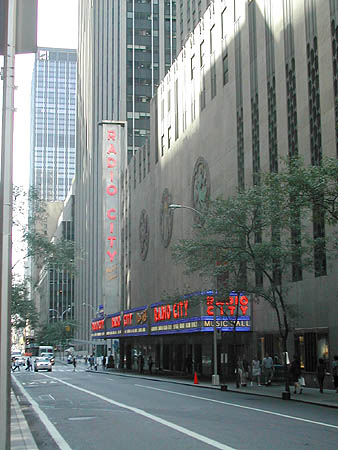
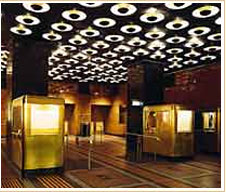 The
most grand and opluent Movie Palaces were built between 1928 and 1930.
Radio City is acknowledged as the last built. Because the very nature
of the film industry
had changed, so were the palaces. Since live attractions similar to
those of Vaudeville before the age of film were now going the way of
the dinosaurs, there was no longer any need for any backstage areas.
Since sound had elminated the need for live musical accompaniment, gone
were the pianos, organs, and orchestra pits. Back stage became nothing
more than a storage room or nothing but a wall. The size of the lobbies
and the lounges were also shrinking because people spent less time at
the theater. True lounges were replaced with simple restrooms.
By the 1940s, most theaters consisted of four areas: the lobby,
the
auditorium, the restrooms, and the office/projection/storage
rooms. Yet the movie theaters were still very important social
centers for thier communites. During World War II, movie theaters
hosted newsreels and war
bond drives, attracting patriotic and news-hungry Americans by
the millions, which hit an estimated post-Depression high of 85 million
patrons each week. Americans packed movie theaters
during the war.
The
most grand and opluent Movie Palaces were built between 1928 and 1930.
Radio City is acknowledged as the last built. Because the very nature
of the film industry
had changed, so were the palaces. Since live attractions similar to
those of Vaudeville before the age of film were now going the way of
the dinosaurs, there was no longer any need for any backstage areas.
Since sound had elminated the need for live musical accompaniment, gone
were the pianos, organs, and orchestra pits. Back stage became nothing
more than a storage room or nothing but a wall. The size of the lobbies
and the lounges were also shrinking because people spent less time at
the theater. True lounges were replaced with simple restrooms.
By the 1940s, most theaters consisted of four areas: the lobby,
the
auditorium, the restrooms, and the office/projection/storage
rooms. Yet the movie theaters were still very important social
centers for thier communites. During World War II, movie theaters
hosted newsreels and war
bond drives, attracting patriotic and news-hungry Americans by
the millions, which hit an estimated post-Depression high of 85 million
patrons each week. Americans packed movie theaters
during the war.
Because of war time rationing, a building ban stateside stopped
construction
of new theaters during World War II, then in 1943 a study commissioned
by the United States Navy concluded that a lack of movie theaters
stateside
actually contributed to delinquency and high labor turnover. The movie
studios and film exhibitors gladly responded to the Navy's call
for new theaters. During the '40s theater builders relied heavily
on concrete since it was the most abundant non-restricted material
available. Thier construction was the same technique used today to
make simple box-like buildings
to house an auditorium. The concrete block walls of the much smaller
auditoriums were often concealed by large curtains. Cinema attendance reached
its all-time
American high in the immediate years following the war, but it was short lived. After the 1940s
ended, everything started to go wrong for the motion picture
industry. .
The tide of American consumerism, which had propelled the movie
palaces to prestige and profitability was now contributing to its downfall.
The political phrase, "a chicken in every pot" had morphed
into "a car in every driveway and a television in every living
room." Americans' pursuit of the material good life led them
to a mass exodus to a new suburbian uptopia. Sub-urbanization was facilitated by the federal
government and automakers in Detroit.
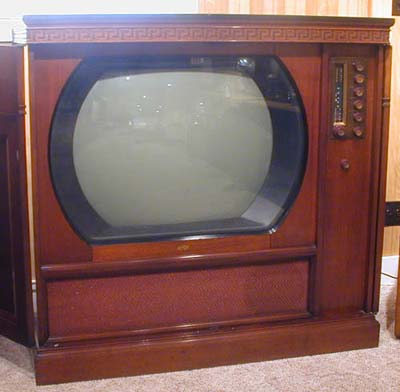 The accompanying lifestyle it called
for spelled doom for downtown movie palaces. The growth of the
suburbs and "urban sprawl" began by repaying the returning
World War Two Veterans for their service through subsidies for
interstate construction, the GI Bill, and the FHA mortgage program.
More and more people were moving farther and farther away from
the big cities where the major movie palaces were. The government promoted
this sprawl by the creation of interstate highway construction
that would allow for people to live farther out from the city
yet be able to get to work in relatively short time thanks to
driving on high-speed roads. While most cities had yet to come
to know modern traffic gridlock, it was soon discovered that once
a worker ended his day of work he wanted to leave the city to
go home and stay there until he returned to work the following day. People did not remain in the downtown
district after work to dine or to go to see a movie. Worst of all,
they wanted to sit in their cushy chairs at home and watch that
electronic demon, the Television, in the comfort of thier pajamas at
home. Pictured at right is the 1951 DuMont Royal Sovereign television
that boasts the largest black and white picture tube ever made
at 30" measured diagonally.
The accompanying lifestyle it called
for spelled doom for downtown movie palaces. The growth of the
suburbs and "urban sprawl" began by repaying the returning
World War Two Veterans for their service through subsidies for
interstate construction, the GI Bill, and the FHA mortgage program.
More and more people were moving farther and farther away from
the big cities where the major movie palaces were. The government promoted
this sprawl by the creation of interstate highway construction
that would allow for people to live farther out from the city
yet be able to get to work in relatively short time thanks to
driving on high-speed roads. While most cities had yet to come
to know modern traffic gridlock, it was soon discovered that once
a worker ended his day of work he wanted to leave the city to
go home and stay there until he returned to work the following day. People did not remain in the downtown
district after work to dine or to go to see a movie. Worst of all,
they wanted to sit in their cushy chairs at home and watch that
electronic demon, the Television, in the comfort of thier pajamas at
home. Pictured at right is the 1951 DuMont Royal Sovereign television
that boasts the largest black and white picture tube ever made
at 30" measured diagonally.
In 1948, the Supreme Court finally heard the law suit against
Vertical Integration and declared in what has become known as the
Paramount Decree that the movie industry's vertical
integration was an unlawful monopoly. The court ruled the movie studios
were to sell off
their theater chains. Up to that point, most studio/theater accountants
simply put all of its operations into one pile. While one theater might
be really profitable, some of those profits balanced out the losses
caused by another theater that was loosing money. It was soon
painfully obvious that the movie palaces had been money loosing crown
jewels the studios kept mainly for prestige. they had been allowed to
remain in operation because of the high profits that had come in
from
the smaller suburban theaters. When the studios sold off their theater
chains, the new owners expected to make a profit from their
investments. Theaters
that could not turn a profit for their new
owners were ordered closed and sold off.
This spelled doom to the majority of
the downtown movie palaces. Since most of the theaters were in densely
packed urban areas, the property they resided on had become highly
desired and valuable. At that time, nobody really gave a second thought
about the historical value or the potential contributions these old Movie Palaces
could make to the arts or society. They were simply buildings that not only didn't
make their owners money, but the cost a lot of money to maintain. It only made good business sense to
sell the property for other purposes, which almost always meant the demolishment.
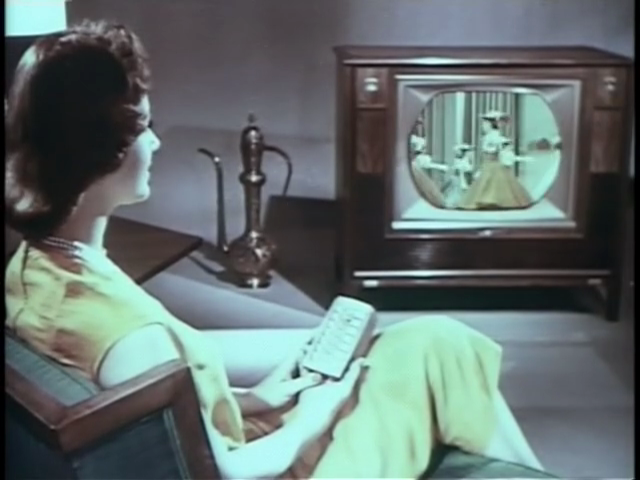 At
the same time, probably the greatest perceived threat to the film
industry at the time was television. Between 1947 and 1957, 90%
of American households acquired a television. While newsreels continued to be made into the 60s, they were a
thing of the past by the mid-1950s; TV news broadcasts meant
people could get the latest news in their homes and much faster whereas the news presented on a newsreel was at least one to two
weeks old when it was shown in the theaters. From the time television
was debuted to the public at the 1939 World's Fair, the TV had
gone from a massive structure with a relatively small imaging
tube to something that a lot of people could watch with relative
ease in a good-sized room in a pretty, yet substantial piece of furniture. As the manufacturing processes switched
from wartime production, televisions were able to be mass-produced
at a cost that became relatively affordable. Radio stations were
now making the transition to television and the choices of what
to watch (and when) greatly improved. While the theaters were
in their dark days, the Golden Age of Television had arrived.
At
the same time, probably the greatest perceived threat to the film
industry at the time was television. Between 1947 and 1957, 90%
of American households acquired a television. While newsreels continued to be made into the 60s, they were a
thing of the past by the mid-1950s; TV news broadcasts meant
people could get the latest news in their homes and much faster whereas the news presented on a newsreel was at least one to two
weeks old when it was shown in the theaters. From the time television
was debuted to the public at the 1939 World's Fair, the TV had
gone from a massive structure with a relatively small imaging
tube to something that a lot of people could watch with relative
ease in a good-sized room in a pretty, yet substantial piece of furniture. As the manufacturing processes switched
from wartime production, televisions were able to be mass-produced
at a cost that became relatively affordable. Radio stations were
now making the transition to television and the choices of what
to watch (and when) greatly improved. While the theaters were
in their dark days, the Golden Age of Television had arrived.
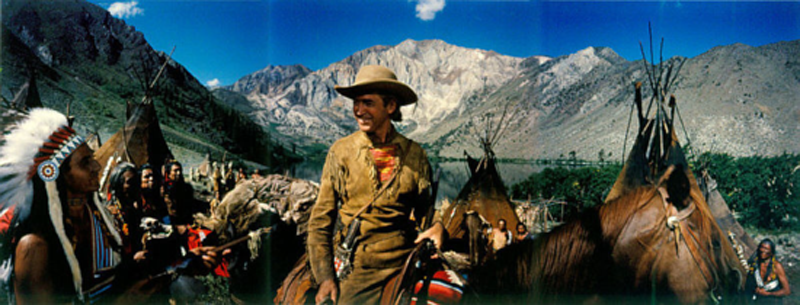
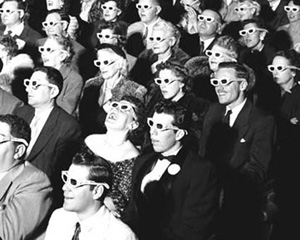 The movie industry was frantic to counter this new competitor,
and in retaliation, they started to renovate their theaters with
such luxuries as air conditioning, large "rocking chair"
seats, wide screen, Cinerama (a frame from "How The West Was Won" is shown above), 3-D motion pictures (audience pictured left), stereophonic
sound, and epic films, all of which meant the renovation of existing
theaters to accommodate a wider screen and thus the destruction
of many elaborate movie palace prosceniums and organ grilles.
One of the attempts to get people back into the cinemas by exhibitors
(and one that makes me grin) was "dish night", a ploy
that was used during the Depression era. For every person that
came to the movie, they would get a piece of dinnerware. The idea
behind it was logical. By getting the whole family out to the
cinema, you'd get a set of dishes for the whole family. You
would return in the subsequent weeks for the other pieces of the
table setting (Dinner plates, roll plates, salad bowls, saucers,
etc.), so this promotion gave the exhibitor a guaranteed number of
patrons for the weeks the promotion was going on. From its all
time high, theater attendance declined to an average of about 42
million patrons per week and continued
to drop. In 1991, average attendance was estimated to be a
dismal 18.9 million per week, compared to its high of 90 million
decades before. Attendance number never really started to increase
until the end of the century.
The movie industry was frantic to counter this new competitor,
and in retaliation, they started to renovate their theaters with
such luxuries as air conditioning, large "rocking chair"
seats, wide screen, Cinerama (a frame from "How The West Was Won" is shown above), 3-D motion pictures (audience pictured left), stereophonic
sound, and epic films, all of which meant the renovation of existing
theaters to accommodate a wider screen and thus the destruction
of many elaborate movie palace prosceniums and organ grilles.
One of the attempts to get people back into the cinemas by exhibitors
(and one that makes me grin) was "dish night", a ploy
that was used during the Depression era. For every person that
came to the movie, they would get a piece of dinnerware. The idea
behind it was logical. By getting the whole family out to the
cinema, you'd get a set of dishes for the whole family. You
would return in the subsequent weeks for the other pieces of the
table setting (Dinner plates, roll plates, salad bowls, saucers,
etc.), so this promotion gave the exhibitor a guaranteed number of
patrons for the weeks the promotion was going on. From its all
time high, theater attendance declined to an average of about 42
million patrons per week and continued
to drop. In 1991, average attendance was estimated to be a
dismal 18.9 million per week, compared to its high of 90 million
decades before. Attendance number never really started to increase
until the end of the century.
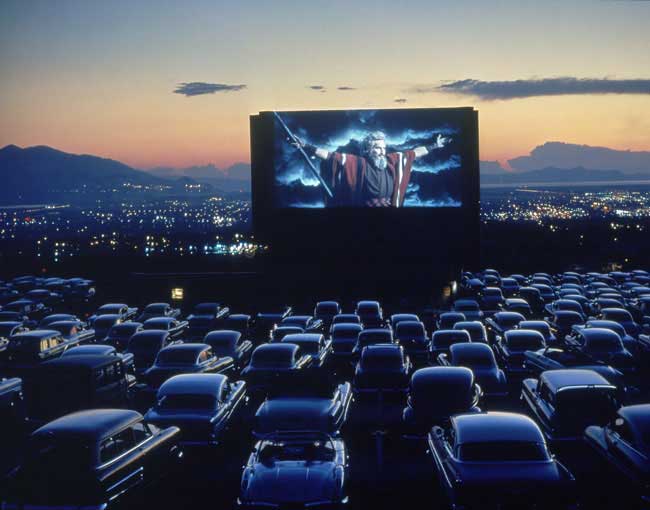
The movie palaces not only faced competition from the evil
television, but that also faced direct competition from the theaters
that were popping up in the suburbs and a new form of theater
that would go on to become another great American icon, the Drive-In
Theater. While Drive-In Theaters began prior to World War II, the post-war boom brought in a new golden age of the automobile
and the love of the car sparked a unique fusion of car and cinema.
The Drive-in was very popular with families that could pay a single
car admission for a carload of adults and kids. While the parents
watched the film, the kids could often go and play at a playground
located behind the large parking ground. Couples loved to go to
drive-ins for the "unique" privacy being inside your
own car provided. America's love affair with the drive-in lasted
for about two decades before it began to fall out of favor in
the 1970s. Just like the movie palaces they competed with, the
property they resided on became highly valued real estate and
a lot of them were torn up for other developments.
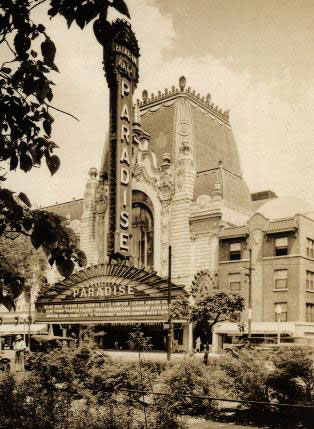
 No
matter what the exhibitors did, it was only minimally effective
in bringing more people to the movie palaces. It was quite apparent
that the days of the large downtown cinema were numbered. One
by one, the big theaters were closing as people either stayed
home or went to smaller theaters located in the sprawling suburbs
that were now being built. Most Palaces were situated on valuable
downtown property. With their owners not being able to pay their
bills, not to mention the large amount of money required to maintain
the palaces, selling off the property to developers was a very
attractive way out of a desperate situation. In 1956, Balaban
and Katz decided to demolish the Paradise Theater in Chicago and
sell the land to a supermarket chain. This was widely considered
to be the start of the darkest days of the Movie Palaces where
the majority of the great houses were destroyed.
No
matter what the exhibitors did, it was only minimally effective
in bringing more people to the movie palaces. It was quite apparent
that the days of the large downtown cinema were numbered. One
by one, the big theaters were closing as people either stayed
home or went to smaller theaters located in the sprawling suburbs
that were now being built. Most Palaces were situated on valuable
downtown property. With their owners not being able to pay their
bills, not to mention the large amount of money required to maintain
the palaces, selling off the property to developers was a very
attractive way out of a desperate situation. In 1956, Balaban
and Katz decided to demolish the Paradise Theater in Chicago and
sell the land to a supermarket chain. This was widely considered
to be the start of the darkest days of the Movie Palaces where
the majority of the great houses were destroyed.
The Paradise Theater was built in the Garfield Park neighborhood
of Chicago, and was billed as the world's most beautiful theater. To
this day it is regarded as one of the greatest movie palaces
ever built. After 3 years of construction, the Paradise opened
for business on 14 September 1928. Its auditorium could hold 3612
patrons in its "atmospheric" hall that was designed
to replicate an open air courtyard with its painted ceiling made
to look like a cloud-filled sky on a warm spring day. The photos
above left and right shown the wonderful exterior and the Paradise's
incredible auditorium. The Paradise put up a fight against its
demolition as the demolition crew discovered that the building
was built substantially better and a lot stronger than the original
blueprint detailed. What was to take a few months took two years
to raze. At one point the demolition foreman committed
suicide because of the stress the project entailed.
One by one, the great Palaces fell. For each of the big theaters
that came down, new smaller theaters would be erected in the fast
growing suburbs. By then, going to the movies had been reduced
from something that was a big outing for the evening to something
that would last for a few hours. Gone were the shorts, the live
acts, the newsreels, and the cartoons. All that was left was the
trailers for coming attractions and the main feature. Part of this was
simple economics. The shorter the program, you could have more showings
in one evening. The exhibitor was only paying for one item to show, yet
his patrons were paying the same admission fee. This meant that with
the old system, you could only have one performance
a night, But with the new system of just the feature film, you could get in
2 or 3 shows in the same auditorium that evening.
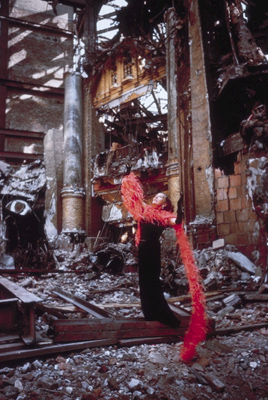
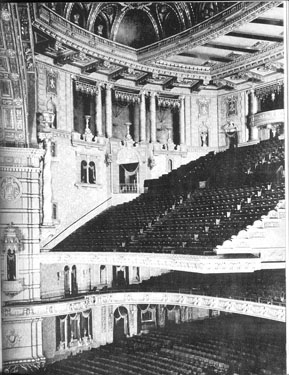 The photo displayed
at left is the great silent film actress Gloria Swanson in a staged
photo for LIFE magazine decrying the destruction of the great movie palaces. While
the exact spot she is standing in is not documented, she is standing
in the ruins of the New York Roxy Theatre as it was being demolished
in 1961. All of the ornate plaster and ornamentation is pretty
much gone from the heavily damaged wall, but you can still make
out a magnificent column just to the right of Ms. Swanson, which
indicates to me she is probably standing where the auditorium
used to be. The Roxy was one of the largest palaces to be built
with an extraordinary seating capacity of over 6,000 as shown
on the photo to the right.
The photo displayed
at left is the great silent film actress Gloria Swanson in a staged
photo for LIFE magazine decrying the destruction of the great movie palaces. While
the exact spot she is standing in is not documented, she is standing
in the ruins of the New York Roxy Theatre as it was being demolished
in 1961. All of the ornate plaster and ornamentation is pretty
much gone from the heavily damaged wall, but you can still make
out a magnificent column just to the right of Ms. Swanson, which
indicates to me she is probably standing where the auditorium
used to be. The Roxy was one of the largest palaces to be built
with an extraordinary seating capacity of over 6,000 as shown
on the photo to the right.
Several of the Palaces had extra stories above or around the
theater for retail and office space. This was a godsend to those
theaters because the revenue created by leases helped offset the
loss of revenue of the theater itself. But that did not save them
all. While the buildings were saved, the theaters were not and
the space they occupied was "re-purposed". Some became
department stores, some became churches, and others were gutted
and made into more retail or office space. The worst bastardization
of a Palace occurred with the Michigan Theatre in Detroit. The
theater was only partially gutted and made into a parking lot.
The stage, the movie screen, and even its stage curtain were left
intact and were standing in the shell of the theater for years.
The ornate lobby became
the location for up and down ramps to the various levels of the
parking lot. Read and see more about this theater on my Michigan Theatre Requiem tribute page.
The theaters in the
smaller towns were a lot luckier than their big cousins. Most
were able to stay afloat because they did not have the direct
competition of other theaters in the same town. They were also much
smaller buildings and usual less orante, which meant it was much less
expensive to maintain compared to the true Palaces. Another major
factor
was that in the smaller towns, real estate was a lot more plentiful
and it was much easier to buy a parcel of undeveloped land to
build on rather than having to demolish or renovate an existing
structure. When a small town theater closed, most of them were
simply boarded up for years or even decades waiting to be
rediscovered and used
once more by the community.
The late fifties, the sixties, and the early seventies were
the darkest time for the Palaces. After we lost the greatest as well as the majority
of the Palaces, people began to take notice of what was lost and what we were on the verge of losing forever.
Most metropolitan areas had several big theaters and by the 1970s
all but one or two of them had been demolished, people began to
stand up and fight to preserve what remained.
At the same time, the smaller, less-ornate movie theaters were
undergoing a transformation. Because of the dwindling attendance
figures, most of the theaters built in the suburbs were not being fully
utilised. On average, most of the houses could seat around 1,000
patrons. More than half the seats were being left empty, especially
after the premiere weekend of a film that by contract, the exhibitor
had to show for a number of weeks. Some enterprising film
exhibitioner came up with a novel idea that
allowed him to double his profits with a minimal amount
of investment. The theater would temporarily close while the
auditorium
was divided into two or more viewing halls. Since less than half of the
seats were being filled, this would give the theater owner two 400 or
more seat
auditoriums that could show 2 different movies at the same time. This
in theory would
double their profits. The concept was very sound and it became all the
rage. The next step in this evolution was to go for even more screens.
Doubling led to Triples and Quads that lead to the
modern concept of Multi-plexing.
Multi-Plexing is now the defacto standard in the movie exhibition
business and its concept goes far to further refine and get the most
profit out of film exhibition. Most plexes have at least one ot two
huge auditoriums that hold several hundred people with smaller and
smaller auditoriums that reduce in size to a where the smallest
could accomodate fewer than 50 patrons. The big halls are used to show
the latest blockbuster from Hollywood that's all the rage. In
getting those blockbusters, the exhibitors still have to sign
agreements that
force them to show that particular film for a certain amount of weeks,
long before it's known if the film is going to be hit or a flop.
The one thing that is not usually dictated is in how large an
auditorium the film is
shown. This allows the exhibitor to place the film in
the right-sized
auditorium. So when he demand for tickets goes down, the film moves to
a smaller auditorium until the contract to show it is expired. Most
contracts also do not require the film be shown all day, so things like
children's matinees can be shown in the same auditorium with a
different film. With today's
technology, they can easily move the film, at almost a
moment's notice to any auditorium in the multi-plex. That way,
when Rocky 25 comes out, it can get the big hall, while Star Trek 46: The Search for a Good Script
fulfills its contractual agreement in the smallest auditorium available
while that one die-hard Trekkie looks on by his or her self.
Here in
Atlanta Georgia there is no longer a single screen full-time
motion
picture
theater in operation. Almost every theatre that is more that 25
years
old is no longer in operation. When
this article was written in 1996, there were only three houses older
than thirty years of age. When this was revised in November of 2010,
there are
only five motion picture houses still in existance that date back to
prior to 1990 in the Atlanta area: The Fox Theatre, a true 1929
movie palace is now an omnibus venue that only shows movies in the
summer; the Garden Hills Cinema was shuttered in 2008 but still is
intact; the Plaza Theater in the Midtown district is now operating as a
non-profit independent "art" film house
that was twinned in the late 1980s; The former AMC Northlake 8
multiplex was recently renovated and made
into the "Movie Tavern" a cinema & drafthouse style theater showing
first-run movies;and the "Earl Smith" Strand Theater on the Square in
Marietta. The Strand completed an intensive multi-million dollar
restoration in 2009 and like the Fox, is now an omnibus theater but
unlike the Fox, it regularly screens films. Of the 20-30 movie
theaters
that once were located in metropolitan Atlanta, only 5
remain!
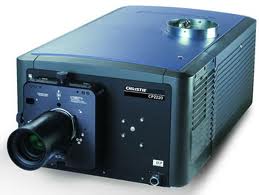 In
2013, movie exhibitors have a new issue to contend with. The Motion
Picture industry is making a huge transition, started by George Lucas
in 1999 with Star Wars I: The Pantom Menace. the film was partially
shot on high-definition video and shown in select theaters via video
projection rather than by film projection. Fourteen years later, 4K and
6K video are rapidly replacing film as the preferred way to present
film. Films can be sent via the Internet through encryption to the
various exhibitioners, totally eliminating local film exchange
distributors. Gone are the days of broken film and hasty edits to put
it back together. Gone are rewinding huge reels or spools of film. In
its place is a rather small DLP "digital" projector (shown at
right). But just as the film projectors when new were rather
expensive, so are the video projectors and support equipment needed to
replace the old ways. I believe it costs around $50,000 and goes
up per auditorium to make the conversion and for some exhibitors that
are living on a close edge between success and failure, that is an
insurmountable fee.
In
2013, movie exhibitors have a new issue to contend with. The Motion
Picture industry is making a huge transition, started by George Lucas
in 1999 with Star Wars I: The Pantom Menace. the film was partially
shot on high-definition video and shown in select theaters via video
projection rather than by film projection. Fourteen years later, 4K and
6K video are rapidly replacing film as the preferred way to present
film. Films can be sent via the Internet through encryption to the
various exhibitioners, totally eliminating local film exchange
distributors. Gone are the days of broken film and hasty edits to put
it back together. Gone are rewinding huge reels or spools of film. In
its place is a rather small DLP "digital" projector (shown at
right). But just as the film projectors when new were rather
expensive, so are the video projectors and support equipment needed to
replace the old ways. I believe it costs around $50,000 and goes
up per auditorium to make the conversion and for some exhibitors that
are living on a close edge between success and failure, that is an
insurmountable fee.
While the smaller single-screen theaters and now even the
Multiplexes are shutting their doors, we are at least blessed that we
still have a handful of the grand
movie palaces in existance. After people realized their historical and
architectural importance, great strives have been made to save
these true treasures.A lot of creative
thought went into how to revitalize the palaces and make them viable in
today's world. Most are becoming omnibus venues presenting
a wide range of different performances. Some have become places of
worship, while others became dinner theaters or homes for local
performing art groups. Regardless of
what the Palaces have become, they all have a common theme of
preserving
one of the most unique pieces of Americana alive for year to come.
 In
the begining, "Moving Pictures", now more commonly known as Motion
Pictures or simply "The Movies" were developed by many people in
many countries with the
major innovators being in the United States and France. Here in the
United States,
moving pictures were mainly pioneered by Thomas Edison's company, best
known for
his development of the electric light bulb and phonograph. His
company was the first to demonstrate moving pictures to the public
in the Americas. His
early experiments followed the same pattern as his phonograph,
with the pictures recorded on to a wax cylinder.
In
the begining, "Moving Pictures", now more commonly known as Motion
Pictures or simply "The Movies" were developed by many people in
many countries with the
major innovators being in the United States and France. Here in the
United States,
moving pictures were mainly pioneered by Thomas Edison's company, best
known for
his development of the electric light bulb and phonograph. His
company was the first to demonstrate moving pictures to the public
in the Americas. His
early experiments followed the same pattern as his phonograph,
with the pictures recorded on to a wax cylinder.  Edison's earliest
films lasted for about 20 seconds or less because of the amount
of film you could put into the camera. They were first demonstrated
to the public in 1893 at the Chicago World's Fair. By the following
year, a "Kinetoscope Parlor" opened in New
York, with ten machines showing different films. At right is an
early Edison film from the same time period that has been converted to an animated
GIF. "
Edison's earliest
films lasted for about 20 seconds or less because of the amount
of film you could put into the camera. They were first demonstrated
to the public in 1893 at the Chicago World's Fair. By the following
year, a "Kinetoscope Parlor" opened in New
York, with ten machines showing different films. At right is an
early Edison film from the same time period that has been converted to an animated
GIF. " As the technology
progressed and longer moves could be made, they began to tell
short stories, but even then, they lasted just a few minutes in length. Kinetoscope parlors
sprang up all over the country and rows of Kinetoscopes were added
to existing entertainment venues like penny arcades. Operators
attempted to attract customers through sidewalk barkers and displays set up in their
wide entranceways.
It became an
enduring feature of movie theater construction still employed
today.
As the technology
progressed and longer moves could be made, they began to tell
short stories, but even then, they lasted just a few minutes in length. Kinetoscope parlors
sprang up all over the country and rows of Kinetoscopes were added
to existing entertainment venues like penny arcades. Operators
attempted to attract customers through sidewalk barkers and displays set up in their
wide entranceways.
It became an
enduring feature of movie theater construction still employed
today.
 The first major step to that goal was taking the movies out of the
"flea pits"
and placing them into proper theaters that befitted the patronage
of refined gentlemen and ladies. Moving into
converted opera houses and purpose-built theaters did a lot to achieve
that
goal. Built in 1902, Tally's "Electric" Theatre in Los Angeles (shown at left) was
the first permanent structure devoted entirely to movies. Audiences immediately preferred the
comfortable, clean, and well-appointed surroundings of a proper
theater. They theaters also featured better-quality musical
accompaniments and even well-dressed ushers to assist patrons.
The first major step to that goal was taking the movies out of the
"flea pits"
and placing them into proper theaters that befitted the patronage
of refined gentlemen and ladies. Moving into
converted opera houses and purpose-built theaters did a lot to achieve
that
goal. Built in 1902, Tally's "Electric" Theatre in Los Angeles (shown at left) was
the first permanent structure devoted entirely to movies. Audiences immediately preferred the
comfortable, clean, and well-appointed surroundings of a proper
theater. They theaters also featured better-quality musical
accompaniments and even well-dressed ushers to assist patrons.  The
Regent (shown at left) was acknowledged as America's first motion picture
palace. Built for and operated by Jacob Fabian, it opened in Paterson,
New Jersey on September 14, 1914. The Regent was located
in a working class neighborhood up-town from the "legitimate" theater
district and stood between Old Union Street (which was later renamed
World Vet's Place in 1959) and Hamilton Street. As it was being
constructed, a majority of people believed that the huge cost of the
building's construction would prove to be a great liability. To that
end, it was oftern referred to as "Fabian's Folly" during the early
days, but once the theater was open and operating, the Regent proved
all of its ney-sayers to be wrong. A reporter for the Motion Picture
News declared that
the opening night audience "
The
Regent (shown at left) was acknowledged as America's first motion picture
palace. Built for and operated by Jacob Fabian, it opened in Paterson,
New Jersey on September 14, 1914. The Regent was located
in a working class neighborhood up-town from the "legitimate" theater
district and stood between Old Union Street (which was later renamed
World Vet's Place in 1959) and Hamilton Street. As it was being
constructed, a majority of people believed that the huge cost of the
building's construction would prove to be a great liability. To that
end, it was oftern referred to as "Fabian's Folly" during the early
days, but once the theater was open and operating, the Regent proved
all of its ney-sayers to be wrong. A reporter for the Motion Picture
News declared that
the opening night audience " Another
form of public entertainment was what was known as
Vaudeville. Vaudeville was a live performance theatrical genre of
variety entertainment
in the United States and Canada from the early 1880s into the early
1930s. Each performance was made up of a series of separate, unrelated
acts grouped together on a common bill. Types of acts included popular
and classical musicians, dancers, comedians, trained animals,
magicians, female and male impersonators, acrobats, illustrated songs,
jugglers, one-act plays or scenes from plays, athletes, lecturing
celebrities, minstrels, and movies. Vaudeville developed from many
sources, including the concert saloon, minstrelsy, freak shows, dime
museums, and literary burlesque. Called "the heart of American show
business," vaudeville was one of the most popular types of
entertainment in North America for several decades. Most performers and
artists joined travelling Vaudeville
troops and they traveled from town to town, but a few continually
performed in
one location. A few performers gained what today we would call
"superstar" levels of popularity and they would strike out on their own
to travel around the country. As film's popularity exploded, it
had a direct and
very negative effect on Vaudeville and in by the 1930s, Vaudeville was
almost
completely put out of business.
Another
form of public entertainment was what was known as
Vaudeville. Vaudeville was a live performance theatrical genre of
variety entertainment
in the United States and Canada from the early 1880s into the early
1930s. Each performance was made up of a series of separate, unrelated
acts grouped together on a common bill. Types of acts included popular
and classical musicians, dancers, comedians, trained animals,
magicians, female and male impersonators, acrobats, illustrated songs,
jugglers, one-act plays or scenes from plays, athletes, lecturing
celebrities, minstrels, and movies. Vaudeville developed from many
sources, including the concert saloon, minstrelsy, freak shows, dime
museums, and literary burlesque. Called "the heart of American show
business," vaudeville was one of the most popular types of
entertainment in North America for several decades. Most performers and
artists joined travelling Vaudeville
troops and they traveled from town to town, but a few continually
performed in
one location. A few performers gained what today we would call
"superstar" levels of popularity and they would strike out on their own
to travel around the country. As film's popularity exploded, it
had a direct and
very negative effect on Vaudeville and in by the 1930s, Vaudeville was
almost
completely put out of business.  the great palaces were
designed and created by three architectural firms: Rapp and Rapp,
John Eberson, and Thomas Lamb for the "Big Five" studios. A healthy competition of sorts was had between the
three firms to see who could out do the others latest achievement.
Each new palace was becoming "the new modern wonder of the
world". Most movie palaces were built mainly employing themes from
Europe's grand architecture. The rule of thumb was the more ornate,
the better.
the great palaces were
designed and created by three architectural firms: Rapp and Rapp,
John Eberson, and Thomas Lamb for the "Big Five" studios. A healthy competition of sorts was had between the
three firms to see who could out do the others latest achievement.
Each new palace was becoming "the new modern wonder of the
world". Most movie palaces were built mainly employing themes from
Europe's grand architecture. The rule of thumb was the more ornate,
the better.  Everything about
the movie palace was designed to make the average citizen feel like a celebrity,
a millionaire, or royalty. When the San Francisco Fox (The exterior
is shown on the left while the lobby is depicted to the right)
opened in June of 1929, newspaper and magazine advertisements
proclaimed:
"No palace of Prince or Princess, no mansion of millionaire
could offer the same pleasure, delight, and relaxation to those
who seek surcease from the work-a-day world, than this, the Arcady
where delicate dreams of youth are spun...Here in this Fox dream
castle, dedicated to the entertainment of all California, is the
Utopian Symphony of the Beautiful, attuned to the Cultural and
Practical...No King...No Queen...had ever such luxury, such varied
array of singing, dancing, talking magic, such complete fulfillment
of joy. The power of this Purple we give to you...for your
entertainment.
You are the monarch while the play is on!"
Everything about
the movie palace was designed to make the average citizen feel like a celebrity,
a millionaire, or royalty. When the San Francisco Fox (The exterior
is shown on the left while the lobby is depicted to the right)
opened in June of 1929, newspaper and magazine advertisements
proclaimed:
"No palace of Prince or Princess, no mansion of millionaire
could offer the same pleasure, delight, and relaxation to those
who seek surcease from the work-a-day world, than this, the Arcady
where delicate dreams of youth are spun...Here in this Fox dream
castle, dedicated to the entertainment of all California, is the
Utopian Symphony of the Beautiful, attuned to the Cultural and
Practical...No King...No Queen...had ever such luxury, such varied
array of singing, dancing, talking magic, such complete fulfillment
of joy. The power of this Purple we give to you...for your
entertainment.
You are the monarch while the play is on!" As the economy slowly recovered,
the picture palaces that survived the Great Depression began to
enjoy a renaissance but it was never to be as it was prior to 1929. The
Great Depression had a tremendous effect on the American Society well
beyond just the financial aspects of the stock market crash. From Black
Monday until mid-1932,
things went from bad to worse before improvements slowly began.
As the economy slowly recovered,
the picture palaces that survived the Great Depression began to
enjoy a renaissance but it was never to be as it was prior to 1929. The
Great Depression had a tremendous effect on the American Society well
beyond just the financial aspects of the stock market crash. From Black
Monday until mid-1932,
things went from bad to worse before improvements slowly began.  The first
Art Deco palace was designed in 1930 by Marcus Priteca. It was the Hollywood
Pantages at Hollywood and Vine in Los Angeles. While many others
were built, without a doubt, the most famous
Art Deco theater, and undeniably the most famous existing movie palace
in the world, is Radio City Music Hall. More than 300 million
people have patronized Radio City to enjoy stage shows, movies,
concerts and special events. Everything about it is larger than
life.
The first
Art Deco palace was designed in 1930 by Marcus Priteca. It was the Hollywood
Pantages at Hollywood and Vine in Los Angeles. While many others
were built, without a doubt, the most famous
Art Deco theater, and undeniably the most famous existing movie palace
in the world, is Radio City Music Hall. More than 300 million
people have patronized Radio City to enjoy stage shows, movies,
concerts and special events. Everything about it is larger than
life.  Radio City Music
Hall opened on December 27, 1932. Donald Deskey designed the Music
Hall's interior spaces. In his design, Deskey chose elegance over
excess, grandeur above glitz. He designed more than thirty separate
spaces, including eight lounges and smoking rooms, each with its
own motif. Given "The Progress of Man" as his general
theme, he created a stunning tribute to human achievement
in art, science and industry. He made art an integral part of
the design, engaging fine artists to create murals, wall coverings
and sculpture; textile designers to develop draperies and carpets;
craftsmen to make ceramics, wood panels and chandeliers. Deskey
himself designed furniture and carpets, and he coordinated the
design of railings, balustrades, signage and decorative details
to complement the theatre's interior spaces. It remains an elegant,
sophisticated, unified tour de force.
Radio City Music
Hall opened on December 27, 1932. Donald Deskey designed the Music
Hall's interior spaces. In his design, Deskey chose elegance over
excess, grandeur above glitz. He designed more than thirty separate
spaces, including eight lounges and smoking rooms, each with its
own motif. Given "The Progress of Man" as his general
theme, he created a stunning tribute to human achievement
in art, science and industry. He made art an integral part of
the design, engaging fine artists to create murals, wall coverings
and sculpture; textile designers to develop draperies and carpets;
craftsmen to make ceramics, wood panels and chandeliers. Deskey
himself designed furniture and carpets, and he coordinated the
design of railings, balustrades, signage and decorative details
to complement the theatre's interior spaces. It remains an elegant,
sophisticated, unified tour de force.
 The
most grand and opluent Movie Palaces were built between 1928 and 1930.
Radio City is acknowledged as the last built. Because the very nature
of the film industry
had changed, so were the palaces. Since live attractions similar to
those of Vaudeville before the age of film were now going the way of
the dinosaurs, there was no longer any need for any backstage areas.
Since sound had elminated the need for live musical accompaniment, gone
were the pianos, organs, and orchestra pits. Back stage became nothing
more than a storage room or nothing but a wall. The size of the lobbies
and the lounges were also shrinking because people spent less time at
the theater. True lounges were replaced with simple restrooms.
By the 1940s, most theaters consisted of four areas: the lobby,
the
auditorium, the restrooms, and the office/projection/storage
rooms. Yet the movie theaters were still very important social
centers for thier communites. During World War II, movie theaters
hosted newsreels and war
bond drives, attracting patriotic and news-hungry Americans by
the millions, which hit an estimated post-Depression high of 85 million
patrons each week. Americans packed movie theaters
during the war.
The
most grand and opluent Movie Palaces were built between 1928 and 1930.
Radio City is acknowledged as the last built. Because the very nature
of the film industry
had changed, so were the palaces. Since live attractions similar to
those of Vaudeville before the age of film were now going the way of
the dinosaurs, there was no longer any need for any backstage areas.
Since sound had elminated the need for live musical accompaniment, gone
were the pianos, organs, and orchestra pits. Back stage became nothing
more than a storage room or nothing but a wall. The size of the lobbies
and the lounges were also shrinking because people spent less time at
the theater. True lounges were replaced with simple restrooms.
By the 1940s, most theaters consisted of four areas: the lobby,
the
auditorium, the restrooms, and the office/projection/storage
rooms. Yet the movie theaters were still very important social
centers for thier communites. During World War II, movie theaters
hosted newsreels and war
bond drives, attracting patriotic and news-hungry Americans by
the millions, which hit an estimated post-Depression high of 85 million
patrons each week. Americans packed movie theaters
during the war.  The accompanying lifestyle it called
for spelled doom for downtown movie palaces. The growth of the
suburbs and "urban sprawl" began by repaying the returning
World War Two Veterans for their service through subsidies for
interstate construction, the GI Bill, and the FHA mortgage program.
More and more people were moving farther and farther away from
the big cities where the major movie palaces were. The government promoted
this sprawl by the creation of interstate highway construction
that would allow for people to live farther out from the city
yet be able to get to work in relatively short time thanks to
driving on high-speed roads. While most cities had yet to come
to know modern traffic gridlock, it was soon discovered that once
a worker ended his day of work he wanted to leave the city to
go home and stay there until he returned to work the following day. People did not remain in the downtown
district after work to dine or to go to see a movie. Worst of all,
they wanted to sit in their cushy chairs at home and watch that
electronic demon, the Television, in the comfort of thier pajamas at
home. Pictured at right is the 1951 DuMont Royal Sovereign television
that boasts the largest black and white picture tube ever made
at 30" measured diagonally.
The accompanying lifestyle it called
for spelled doom for downtown movie palaces. The growth of the
suburbs and "urban sprawl" began by repaying the returning
World War Two Veterans for their service through subsidies for
interstate construction, the GI Bill, and the FHA mortgage program.
More and more people were moving farther and farther away from
the big cities where the major movie palaces were. The government promoted
this sprawl by the creation of interstate highway construction
that would allow for people to live farther out from the city
yet be able to get to work in relatively short time thanks to
driving on high-speed roads. While most cities had yet to come
to know modern traffic gridlock, it was soon discovered that once
a worker ended his day of work he wanted to leave the city to
go home and stay there until he returned to work the following day. People did not remain in the downtown
district after work to dine or to go to see a movie. Worst of all,
they wanted to sit in their cushy chairs at home and watch that
electronic demon, the Television, in the comfort of thier pajamas at
home. Pictured at right is the 1951 DuMont Royal Sovereign television
that boasts the largest black and white picture tube ever made
at 30" measured diagonally. At
the same time, probably the greatest perceived threat to the film
industry at the time was television. Between 1947 and 1957, 90%
of American households acquired a television. While newsreels continued to be made into the 60s, they were a
thing of the past by the mid-1950s; TV news broadcasts meant
people could get the latest news in their homes and much faster whereas the news presented on a newsreel was at least one to two
weeks old when it was shown in the theaters. From the time television
was debuted to the public at the 1939 World's Fair, the TV had
gone from a massive structure with a relatively small imaging
tube to something that a lot of people could watch with relative
ease in a good-sized room in a pretty, yet substantial piece of furniture. As the manufacturing processes switched
from wartime production, televisions were able to be mass-produced
at a cost that became relatively affordable. Radio stations were
now making the transition to television and the choices of what
to watch (and when) greatly improved. While the theaters were
in their dark days, the Golden Age of Television had arrived.
At
the same time, probably the greatest perceived threat to the film
industry at the time was television. Between 1947 and 1957, 90%
of American households acquired a television. While newsreels continued to be made into the 60s, they were a
thing of the past by the mid-1950s; TV news broadcasts meant
people could get the latest news in their homes and much faster whereas the news presented on a newsreel was at least one to two
weeks old when it was shown in the theaters. From the time television
was debuted to the public at the 1939 World's Fair, the TV had
gone from a massive structure with a relatively small imaging
tube to something that a lot of people could watch with relative
ease in a good-sized room in a pretty, yet substantial piece of furniture. As the manufacturing processes switched
from wartime production, televisions were able to be mass-produced
at a cost that became relatively affordable. Radio stations were
now making the transition to television and the choices of what
to watch (and when) greatly improved. While the theaters were
in their dark days, the Golden Age of Television had arrived. 
 The movie industry was frantic to counter this new competitor,
and in retaliation, they started to renovate their theaters with
such luxuries as air conditioning, large "rocking chair"
seats, wide screen, Cinerama (a frame from "
The movie industry was frantic to counter this new competitor,
and in retaliation, they started to renovate their theaters with
such luxuries as air conditioning, large "rocking chair"
seats, wide screen, Cinerama (a frame from "

 No
matter what the exhibitors did, it was only minimally effective
in bringing more people to the movie palaces. It was quite apparent
that the days of the large downtown cinema were numbered. One
by one, the big theaters were closing as people either stayed
home or went to smaller theaters located in the sprawling suburbs
that were now being built. Most Palaces were situated on valuable
downtown property. With their owners not being able to pay their
bills, not to mention the large amount of money required to maintain
the palaces, selling off the property to developers was a very
attractive way out of a desperate situation. In 1956, Balaban
and Katz decided to demolish the Paradise Theater in Chicago and
sell the land to a supermarket chain. This was widely considered
to be the start of the darkest days of the Movie Palaces where
the majority of the great houses were destroyed.
No
matter what the exhibitors did, it was only minimally effective
in bringing more people to the movie palaces. It was quite apparent
that the days of the large downtown cinema were numbered. One
by one, the big theaters were closing as people either stayed
home or went to smaller theaters located in the sprawling suburbs
that were now being built. Most Palaces were situated on valuable
downtown property. With their owners not being able to pay their
bills, not to mention the large amount of money required to maintain
the palaces, selling off the property to developers was a very
attractive way out of a desperate situation. In 1956, Balaban
and Katz decided to demolish the Paradise Theater in Chicago and
sell the land to a supermarket chain. This was widely considered
to be the start of the darkest days of the Movie Palaces where
the majority of the great houses were destroyed.
 The photo displayed
at left is the great silent film actress Gloria Swanson in a staged
photo for LIFE magazine decrying the destruction of the great movie palaces. While
the exact spot she is standing in is not documented, she is standing
in the ruins of the New York Roxy Theatre as it was being demolished
in 1961. All of the ornate plaster and ornamentation is pretty
much gone from the heavily damaged wall, but you can still make
out a magnificent column just to the right of Ms. Swanson, which
indicates to me she is probably standing where the auditorium
used to be. The Roxy was one of the largest palaces to be built
with an extraordinary seating capacity of over 6,000 as shown
on the photo to the right.
The photo displayed
at left is the great silent film actress Gloria Swanson in a staged
photo for LIFE magazine decrying the destruction of the great movie palaces. While
the exact spot she is standing in is not documented, she is standing
in the ruins of the New York Roxy Theatre as it was being demolished
in 1961. All of the ornate plaster and ornamentation is pretty
much gone from the heavily damaged wall, but you can still make
out a magnificent column just to the right of Ms. Swanson, which
indicates to me she is probably standing where the auditorium
used to be. The Roxy was one of the largest palaces to be built
with an extraordinary seating capacity of over 6,000 as shown
on the photo to the right. In
2013, movie exhibitors have a new issue to contend with. The Motion
Picture industry is making a huge transition, started by George Lucas
in 1999 with Star Wars I: The Pantom Menace. the film was partially
shot on high-definition video and shown in select theaters via video
projection rather than by film projection. Fourteen years later, 4K and
6K video are rapidly replacing film as the preferred way to present
film. Films can be sent via the Internet through encryption to the
various exhibitioners, totally eliminating local film exchange
distributors. Gone are the days of broken film and hasty edits to put
it back together. Gone are rewinding huge reels or spools of film. In
its place is a rather small DLP "digital" projector (shown at
right). But just as the film projectors when new were rather
expensive, so are the video projectors and support equipment needed to
replace the old ways. I believe it costs around $50,000 and goes
up per auditorium to make the conversion and for some exhibitors that
are living on a close edge between success and failure, that is an
insurmountable fee.
In
2013, movie exhibitors have a new issue to contend with. The Motion
Picture industry is making a huge transition, started by George Lucas
in 1999 with Star Wars I: The Pantom Menace. the film was partially
shot on high-definition video and shown in select theaters via video
projection rather than by film projection. Fourteen years later, 4K and
6K video are rapidly replacing film as the preferred way to present
film. Films can be sent via the Internet through encryption to the
various exhibitioners, totally eliminating local film exchange
distributors. Gone are the days of broken film and hasty edits to put
it back together. Gone are rewinding huge reels or spools of film. In
its place is a rather small DLP "digital" projector (shown at
right). But just as the film projectors when new were rather
expensive, so are the video projectors and support equipment needed to
replace the old ways. I believe it costs around $50,000 and goes
up per auditorium to make the conversion and for some exhibitors that
are living on a close edge between success and failure, that is an
insurmountable fee.